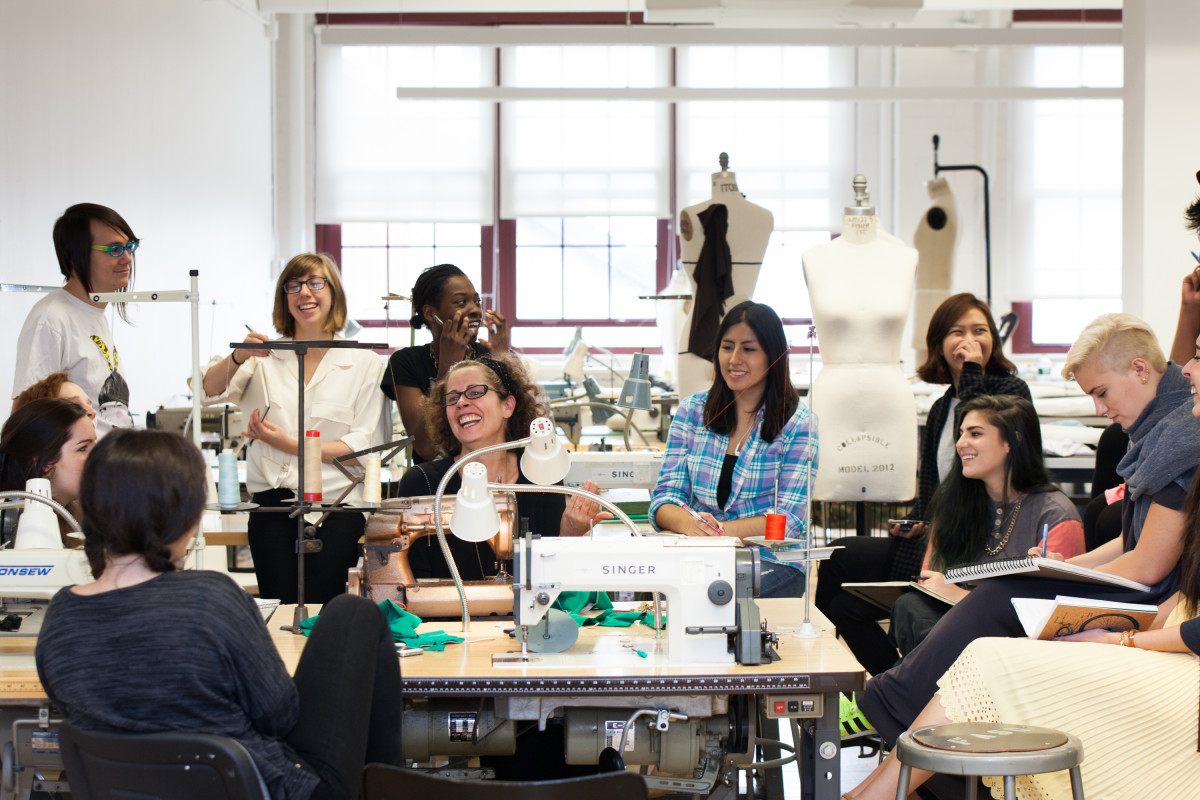The conversation around size inclusivity in fashion isn’t new — it’s been brought up by advocates, models, designers, journalists and others serving this market, which represents the majority of women in the United States, for many, many years. It’s had moments of ebb and flow, but it’s not yet taken a more permanent hold of the industry.
Take, for example, the most recent fashion month: According to Vogue Business, of 9,584 looks across 230 shows and presentations in New York, London, Milan and Paris for Spring 2024, less than 1% of models were plus-size. And of the 103 brands that included curvy models in their debuts, most were smaller, independent labels. (Though, established houses such as Ferragamo, Chloé and Moschino did show signs of improvement.)
While industry leaders should be held accountable for what steps are being taken (or not) to achieve institutional change and greater representation in fashion, classrooms across the globe are filled with the next generation of professionals, and their education is key to ushering in a more inclusive future. Historically, extended sizing has been left out of most design curriculum, but that’s finally starting to change.
Photo: Hitoshi Ujiie/Courtesy of Thomas Jefferson University
“Size inclusivity and inclusivity overall have been a major component of how we teach our classes, and it really starts with ensuring that we provide our students the tools in order to consider size inclusivity,” Farai Simoyi, assistant professor and program director of fashion design at Thomas Jefferson University, tells Fashionista. “For example, all of our studios now carry different branded curvy or plus size — or just mostly size-inclusive — dress forms… So, when students are in specific classes, they have the ability to design what they want. If they see a size-inclusive dress form, they’re more likely to consider designing for that, as opposed to only seeing size two or four dress forms in the studio. It’s not always just about talking about it, it’s also about showing.”
Pratt Institute has taken a similar approach, providing design students with dress forms going up to a size 22, a curve fit model and electives focused on body diversity.
“Over the last maybe four or five years, we have gone over every syllabus with a fine tooth comb to make sure there’s diversity, equity and inclusion in size and gender, wherever appropriate for the course,” says Karin Yngvesdotter, adjunct professor of Pratt’s fashion program. It doesn’t strictly stop at the undergraduate level: Pratt is preparing to launch its Master’s in fashion starting next fall, and there are already “election classes in discussion about not only sizing and gender diversity, but possibly even ability and disability diversity,” according to Yngvesdotter.

Photo: Courtesy of Pratt Institute
When talking about size inclusivity in fashion, there’s an underlying concern of it being treated as nothing more than a passing trend. In a similar vein to issues such as sustainability and greenwashing, it may be a hot topic today, but without a greater shift in mind frame, there’s nothing that protects it from becoming passé tomorrow.
Savannah College of Art and Design (SCAD) encourages students to embrace a forward-thinking approach, the latest example of which is a new inclusive fashion design minor, starting in January 2024.
“It’s basically aligned on the specific brief that the future of fashion should serve all people,” Fashion Professor Ellen Fowles says of the program. It’s about “thinking about inclusive design as more of a methodology, trying to counter design exclusion, thinking about who can’t really use a product or a service, trying to analyze why and then completely turn that on its head; including and involving as many people and communities as possible, thinking about people of different ages, abilities, genders, cultures, body types… Obviously, it’s a concept that can be applied to all different design disciplines, and we’re incredibly excited to focus on it as part of the wider SCAD fashion curriculum.”

Photo: Courtesy of SCAD
Fowles argues that to have a true inclusive mindset is to recognize how size inclusion goes hand-in-hand with addressing other global issues, especially sustainability.
“Thinking about that more practically, our bodies are obviously changing as we age, so making more clothing that’s adaptive, adjustable to fit different body shapes, directly relates and is really crucial to try and enable more of a circular and anti-fast fashion system,” she says. “Both as designers and consumers, we should be trying to look for garments that are made to last and therefore adapt to our bodies over time.”

Photo: Courtesy of SCAD
At New York’s Fashion Institute of Technology (FIT), student demand for concentrating on important issues in fashion, such as size inclusion, has fueled changes to the curriculum.
“(The students) are actually leading the change,” says Amy Sperber, FIT’s assistant professor in fashion design. “We do a lot of it in our BFA program, where the students are on a thesis track, and a lot of their individual approaches are (focused on areas such as) body diversity and gender neutrality. Whatever the space they want to focus on, we support that.”
There are also opportunities for those already working in the industry who want to expand their design skills to be more inclusive. This fall, FIT launched its “Inclusive Fashion Patternmaking” course, spearheaded by Mallorie Dunn of SmartGlamour, under its Continuing Education department; it covers how to create and grade patterns for plus-size customers, an overview of size chart creation, measurement data and marketing.

Photo: Lorenzo Ciniglio/Courtesy of FIT
This inclusive foundation should extend beyond fashion design programs. “When you have a line that’s created by a designer that’s size-inclusive, you need the merchandiser or the salesperson to understand how to sell that product. So I believe the education has to span all aspects,” Simoyi argues. “Graphic designers or media students now have to understand how to market that product or that brand to potential customers. It has to be the entire fashion and design ecosystem working together.”
Today’s youth has not been shy in calling out the glaring gaps that still remain in the fashion industry, from the gross underrepresentation of larger sizes, to the lack of inclusion around race, gender and disabilities. The disconnect doesn’t necessarily come from malicious intent, but rather stems from habit and from abiding by outdated “rules” established by the exclusionary systems already in place, which, according to Fowles, can “set up designers to potentially design in a specific way, that’s maybe a little bit outdated.”

Photo: Courtesy of FIT
A lack of understanding doesn’t excuse a neglect of effort. But educators are particularly hopeful for the future as young designers continue to demonstrate a desire to build a more inclusive industry and to challenge the status quo.
“I can guarantee you when this 18-year-old has an opportunity to be in a leadership position 20 years from now, they’re the ones that are going to be making the decisions and really changing the face (of fashion),” Simoyi says. “What we’re talking about isn’t going to happen overnight, and it’s not going to happen today, but give it 10 years. The whole entire industry is going to change, and whoever’s not on that rocket ship is going to be left behind.”
Want the latest fashion industry news first? Sign up for our daily newsletter.



